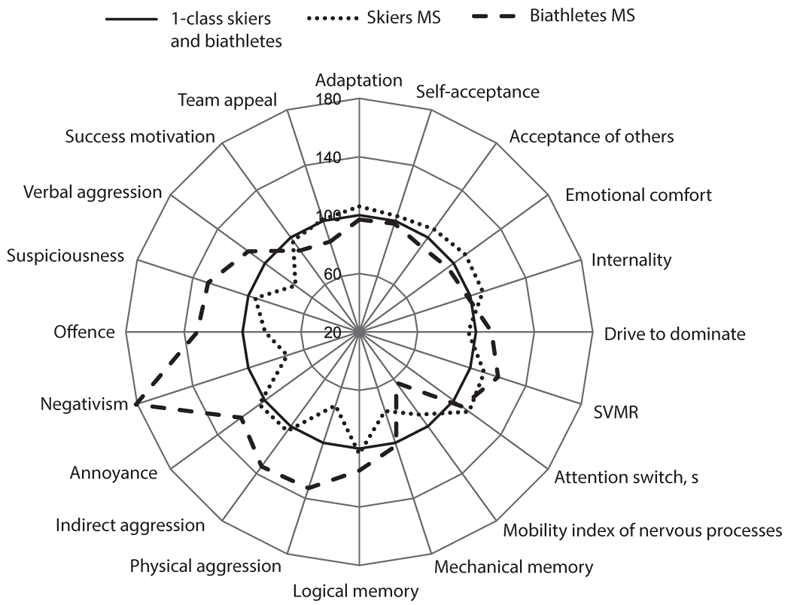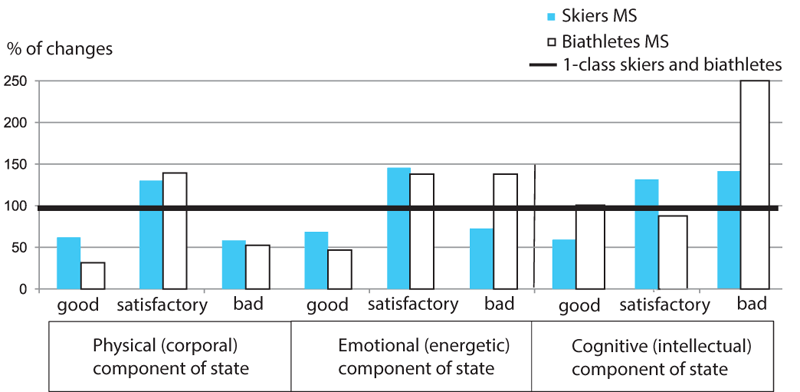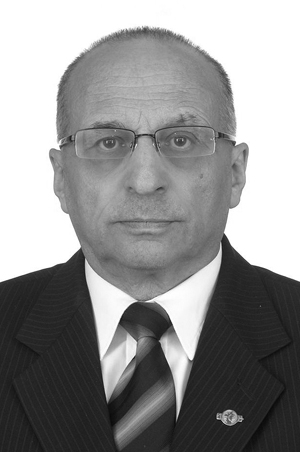Psychophysiological characteristics of racing skiers and biathletes of different levels of sportsmanship
Фотографии:
ˑ:
Introduction. Despite the outer similarity, cross country ski races and biathlon essentially differ from each other. Many biathletes are originally skiers, but such a practice does not facilitate the progress in sports results in biathlon for as opposed to ski races, biathlon combines two kinds of sport contrary by their requirements to physiological body systems [3]. The differences in the specifics of these sports make various requirements from the ones who train related to the level of development of physiological and psychophysiological qualities, which when combined in many respects defines achievements of high sports results [9]. A relevant qualification takes place during training sessions, since not all skiers become successful in biathlon. In modern biathlon the speed of ski race or shooting cannot be singled out as a basic determining component, as at the present competition success can be achieved only in case of the rational combination of these two constituents in biathlete's complex training [2, 5].
Hence the purpose of the present study was to investigate psychophysiological, neurodynamic and personality characteristics of skiers and biathletes with different skill levels.
Materials and methods. 18-22-year old males, engaged in cross country skiing (n=38) and biathlon (n=28), were the subjects of the study. Regarding training experience and skill level the examined groups had an approximately equal number of 1-class athletes and Masters of Sports. The examination was carried out in the competitive period in the first half of the day. The exercises were not performed on the day of the examination and the day before.
The psychophysiological indices examined in the athletes were diagnosed using the software "Methods of integrated health assessment of athletes", which included the study of the following parameters: pre-contest state of athletes, time of simple visual-motor response, response to a moving object, state of aggression (by the Buss-Durkee Hostility Inventory), personality test (by Eysenck), State-Trait Anxiety Inventory (by CH.D. Spilberg – Yu.L. Khanin), attention level, short-term memory capacity, sociopsychological adaptation level (by A. K. Osnitsky), stress resistance, strength of the motivation to avoid failure (according to A. Mehrabian), success motivation assessment (by Ehlers ) as well as studies of the team appeal for athletes [1 , 10].
All these values were processed by the common methods of mathematical statistics using the Wilcoxon-Mann-Whitney nonparametric test for independent samples and were considered reliable at p ≤ 0,05.
Results and discussion. All subjects were divided into 4 groups depending on sports and sport skill levels to estimate psychophysiological indices (Table). To get more specific distinctions we did not consider candidates for master of sports, as they occupy the intermediate position at the phase of improvement of sport skills.
Athletes of all groups are characterized by low neurotism level, emotional stability, average extraversion and the same motivation to self-acceptance and to avoid failures. Masters of Sport and first class athletes do not differ in terms of stress resistance, reactive and personal anxiety. It can be assumed that the cross country skiing and biathlon sessions are assumed to do no harm for the stipulated psychophysiological indices.
Table. The psychophysiological indices of skiers and biathletes in view of sports qualification, M±m
|
Indices |
1-class skiers |
Skiers MS |
1-class biathletes |
Biathlon MS |
|||
|
Extraversion |
Points |
12,4±0,6 |
12,3±0,8 |
12,8±1,2 |
12,7±0,6 |
||
|
Neurotism |
11,5±1,5 |
9,5±1,5 |
10,7±0,8 |
10,2±1,5 |
|||
|
Adaptation level |
69,1±2,1 |
73,1±1,7* |
68,0±3,9 |
66,1±3,2 |
|||
|
Self-acceptance |
81,7±2,3 |
84,6±1,8 |
79,7±4,0 |
78,6±3,1 |
|||
|
Acceptance of others |
68,8±2,0 |
73,5±2,1* |
70,6±4,9 |
65,2±3,0 |
|||
|
Emotional comfort |
70,5±3,4 |
77,5±3,3* |
69,8±4,8 |
66,5±4,6 |
|||
|
Internality |
72,4±2,6 |
78,8±2,1* |
70,2±4,0 |
69,1±3,3 |
|||
|
Drive to dominate |
68,6±2,0 |
65,0±3,3 |
56,9±4,2 |
63,0±3,2 |
|||
|
Stress resistance |
36,4±1,3 |
33,5±1,7 |
33,4±1,9 |
34,6±1,5 |
|||
|
Reactive anxiety |
18,8±1,6 |
17,5±1,4 |
21,4±2,4 |
20,7±2,1 |
|||
|
Personal anxiety |
33,5±1,5 |
31,7±1,6 |
34,4±2,7 |
34,2±2,2 |
|||
|
SVMR, ms |
185,8±3,3 |
205±14,4* |
185,4±9,9 |
222±18,3* |
|||
|
Attention switch, s |
50,3±3,1 |
56,7±4,4 |
54,3±6,3 |
58,3±6,6 |
|||
|
Mobility index of nervous processes |
1,79±0,02 |
1,61±0,02* |
2,74±0,10 |
1,73±0,20* |
|||
|
Level of types of manifestation of aggression |
Physical aggression |
5,6±0,3 |
4,1±0,4* |
4,6±0,5 |
6,1±0,4* |
||
|
Indirect aggression |
4,5±0,4 |
4,7±0,5 |
3,3±0,4 |
4,4±0,3* |
|||
|
Annoyance |
4,2±0,5 |
4,4±0,6 |
3,0±0,7 |
3,6±0,7 |
|||
|
Negativism |
2,5±0,3 |
1,8±0,4* |
1,6±0,3 |
2,9±0,3* |
|||
|
Offence |
3,9±0,4 |
3,3±0,5 |
3,5±0,4 |
4,6±0,4* |
|||
|
Suspiciousness |
5,8±0,3 |
5,5±0,6 |
5,1±0,4 |
6,6±0,6* |
|||
|
Verbal aggression |
7,3±0,3 |
5,4±0,4* |
6,5±0,4 |
7,4±0,4* |
|||
|
Sense of guilt |
5,2±0,5 |
4,8±0,5 |
6,1±0,7 |
5,3±0,5 |
|||
|
Mechanical memory capacity |
Points |
5,4±0,4 |
4,2±0,5* |
4,8±0,5 |
4,9±0,6 |
||
|
Logical memory capacity |
8,3±0,3 |
8,6±0,4 |
7,8±0,6 |
9,0±0,3* |
|||
|
Success motivation by Ehlers |
19,2±0,8 |
18,7±0,8 |
21,5±1,1 |
19,1±0,7* |
|||
|
Motivation to avoid failure |
143,3±2,8 |
141,4±4,5 |
124,6±6,1 |
125,0±2,2 |
|||
|
Team appeal |
19,1±0,6 |
19,3±0,9 |
17,6±0,3 |
15,0±1,7* |
|||
|
Pre-contest state, points |
Physical (corporal) component of state |
good |
3,7±0,6 |
2,3±0,3* |
4,1±0,6 |
1,2±0,3* |
|
|
satisf. |
5,3±0,6 |
6,9±0,4* |
5,9±0,9 |
8,0±0,3* |
|||
|
bad |
1,2±0,3 |
0,7±0,3 |
0,4±0,2 |
0,2±0,1 |
|||
|
Emotional (energetic) component of state |
good |
4,8±0,5 |
3,3±0,4* |
5,0±0,5 |
2,2±0,3* |
||
|
satisf. |
3,5±0,5 |
5,1±0,5* |
4,6±0,8 |
6,2±0,5* |
|||
|
bad. |
2,2±0,3 |
1,6±0,3* |
1,1±0,4 |
1,5±0,2 |
|||
|
Cognitive (intellectual) component of state |
good |
4,9±0,6 |
2,9±0,6* |
4,1±0,9 |
4,0±0,4 |
||
|
satisf. |
4,1±0,6 |
5,4±0,6* |
5,9±1,1 |
5,0±0,3 |
|||
|
bad |
1,2±0,2 |
1,7±0,5 |
0,4±0,2 |
1,0±0,3* |
|||
Note. The reliability of the intraspecific differences between athletes with various skill levels: * р<0,05.
Skiers - masters of sport were proved to have higher indices of sociopsychological adaptation compared to first-class athletes, except for self-acceptance and drive to dominate, while biathletes lack any reliable variance.
As shown in Table 1, the mobility index of nervous processes, speed of simple visual-motor response and attention switch is lower among masters of sport - skiers and biathletes compared to first-class athletes. It must be due to developed fatigue at the competitive phase in elite athletes.
The mechanical memory capacity of skiers - masters of sport is lower than of first-class athletes, while the logical memory capacity is the same. The logical memory capacity rises in biathletes - masters of sport with the increase of sports skills, whereas the mechanical memory level remains unchanged. Meanwhile, according to the findings, the mechanical memory indices are lower than standard age values among masters of sport (7±2 points).
As compared with first-class athletes, skiers – masters of sport have a reliable decrease of the negativism level, verbal and physical aggression that can be due to more strenuous sports loadings with the rise of sport skills. While biathletes – masters of sport have higher indices of offence, suspiciousness, indirect, physical and verbal aggression compared with first-class athletes. This must be this kind of sport with a high competitive level that forms more pronounced aggressive qualities.
Athlete’s success motivation is one of the key qualities, determining achievement of professional results. The examined skiers did not differ in the success motivation index and team appeal, whereas biathletes - masters of sport had lower indices compared to first-class athletes.
Elite athletes had the same ratio of the pre-contest state indices at all pre-contest phases (physical, emotional and cognitive). Good and bad pre-contest states in masters of sport are significantly lower, and the satisfactory state is more expressed rather than among first-class athletes, except for the cognitive component. Thus, pre-contest states balance with small number of extreme cases (good and bad) with the enhancement of sport skills, indicating to formation of the self-control ability before a competition. In biathlon the integral result is greatly related to biathlete’s readiness to change from one type of activity to another and on the ability to control his mental stress [6].
To estimate the effect from skiing and biathlon sessions on psychophysiological qualities of the engaged ones, we calculated the rate of changes of the indices in masters of sport, compared with first-class athletes. As shown on Fig. 1, the nature and extent of the changes of psychophysiological indices of skiers and biathletes differ greatly during mastering of sports skills. As compared with first-class athletes, skiers - masters of sport had a significant increase of the indices of all forms of sociopsychological adaptation, along with the observed decrease of the values in biathletes.
With the growth of sport skills skiers and biathletes had an approximately the same decrease of simple visual-motor response and attention switch, whereas the decrease in the mobility of nervous processes was more pronounced among biathletes. The mechanical memory capacity decreases in skiers - masters of sport, while biathletes suffered an increase of logical memory.
Skiers had a decrease of the drive to dominate and all indices of aggression, except for annoyance and indirect aggression, while biathletes had a significant rise of these indices.

Fig. 1. Level of changes of psychophysiological indices in masters of sport compared to first-class athletes.
Note. Indices of 1-class skiers and biathletes are taken as 100%
Athlete should be interested in sport not only when beginners but keep interested all sports life long. If there is no interest any more, sooner or later the athlete stops training even if offered a good financial reward [4]. However, in our study, a decrease of success motivation and team appeal is observed among biathletes - masters of sport, unlike skiers where such changes have not been identified. The lower perspective for being qualified for the national team due to the high level of competition can be one of the reasons for this.
Skiers and biathletes’ indices of pre-contest state change with the growth of sports skills. The skiers’ good state becomes worse at all levels, along with bad physical and emotional ones, while the indices of satisfactory conditions and bad cognitive condition rise. Biathletes - masters of sport are characterized by the decrease of good emotional state and good and bad physical state. Meanwhile, their levels of satisfactory physical, emotional and bad cognitive states increase significantly.

Fig. 2. The level of change of pre-contest indices in masters of sport.
Note. The indices of 1-class skiers and biathletes are taken as 100%.
Conclusion. According to literature sources [6], the issues of psychological support of biathletes’ training, including the ones who only start their sports career, are extremely acute. The issue of psychophysiological selection, psychological training and continuous monitoring of psychophysiological indices is very acute, for modern sport is on the way of development, where additional purposes and potentials are provided by athlete’s psychological training. Along with taken into account dynamics of sports enhancement the estimation and predicting of athlete’s mental resistance to competitive conditions are also important [8]. The role of morphological characteristics decreases and the value of functional and mental state increases with age and improvement of skill level [7]. In this situation relevant knowledge is required from the engaged one and trainers, along with the continuous monitoring of psychophysiological qualities and correcting the training process.
The present work contains the results indicating to psychophysiological features of representatives of externally similar but different sports that can be important for sports qualification and skills improvement. The lack of emotionally-volitional and personality differences is common between skiers and biathletes. The most significant difference was detected in the indices of aggression, sociopsychological adaptation, personality’s motivational component and neurodynamic indices. These psychophysiological features should be taken into account when improving sport skills and qualification for relevant sports
References
- Aizman, R.I. Technique of integrated assessment of athletes' health / R.I. Aizman, A.V. Lebedev, V.B. Rubanovich. – NovosibirsK, 2009. – 84 P. (In Russian)
- Gibadullin, I.G. Control of biathletes' training process in the system of long-term training: doctoral thesis (Hab.) / I.G. Gibadullin. – Izhevsk, 2005. – 368 P. (In Russian)
- Grebennikova, I.N. Age dynamics of indices of functional systems, determining sports result in women's biathlon: Ph.D. thesis / I.N. Grebennikova. – Novosibirsk, 2002. – 159 P. (In Russian)
- Ezhkova, A.Yu. Psychological and pedagogical support of the interest in sports of beginning wrestlers: abstract of Ph.D. thesis / A.Yu. Ezhkova. – St.Petersburg, 2004. – 215 P. (In Russian)
- Smirnov, Yu.I. Integrated monitoring in athletes' training / Yu.I. Smirnov. – Moscow: Fizkultura i sport, 1987. – 256 P. (In Russian)
- Sorokina, A.V. Technology of psychological and pedagogical support of shooting training of biathletes' in children's sport schools: Ph.D. thesis / A.V. Sorokina. – Tyumen, 2010. – 218 P. (In Russian)
- Stepanov, A.N. Selection of children for biathlon occupations and manning of training groups on the initial stage of specialization: abstract of Ph.D. thesis / A.N. Stepanov. – Omsk, 1983. – 19 P. (In Russian)
- Farbey, V.V. Training of biathletes aged 13-16 in the transition period of training using technical training aids: Ph.D. thesis / V.V. Farbey. – St.Petersburg 2000. – 153 P. (In Russian)
- Farbey, V.V. Pedagogical and medicobiological criteria of selection in biathlon / V.V. Farbey // Izvestiya Rossiyskogo gosudarstvennogo pedagogicheskogo universiteta imeni A.I. Gertsena. – St.Petersburg, 2008. – № 11(62). (In Russian)
- Shapar', V.B. Practical psychology. Instruments / V.B. Shapar'. – Rostov-on-D.: Fenix, 2002. – 688 P. (In Russian)
Author’s contacts: aizman.roman@yandex.ru



 Журнал "THEORY AND PRACTICE
Журнал "THEORY AND PRACTICE